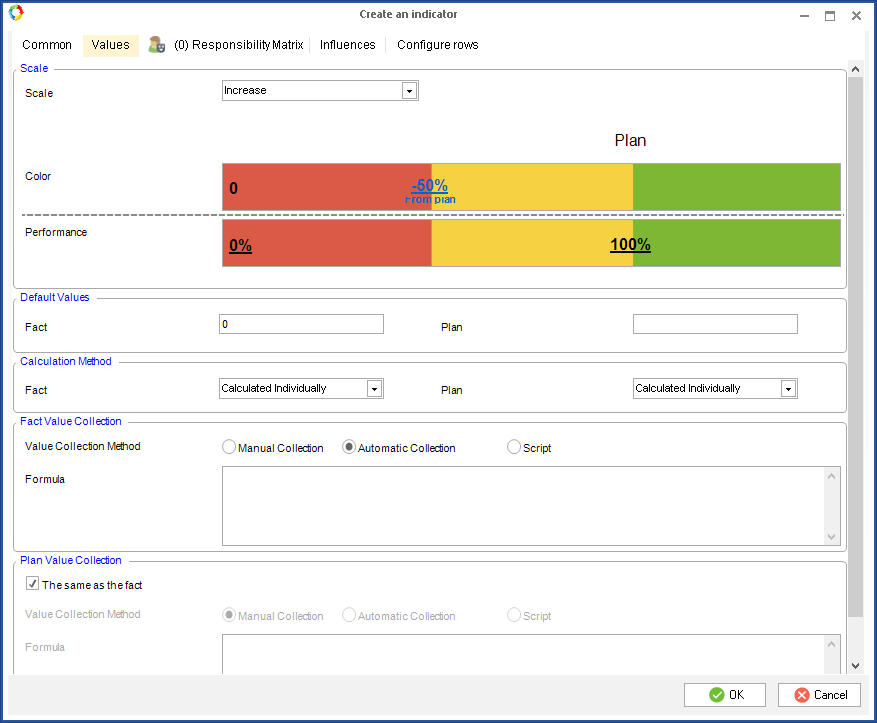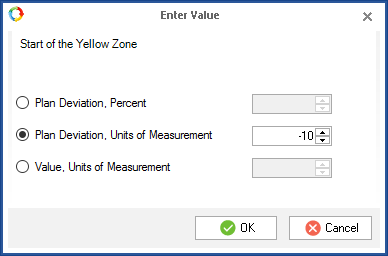On this tab, you configure the KPI values calculation and the display of its status.
Fig. 1. Values tab
The settings on this tab are grouped in the following sections:
Here you can set up the following:
-
Color indication of a KPI according to the ratio between the plan and fact value (Color scale);
-
KPI efficiency in the points where Fact=0 and Fact=Plan (Performance scale).
ELMA uses several scale types:
1. Stabilization (fig. 2) - Select it for KPIs, whose values must be within a specific range. The range of the expected positive result (green) is defined by the planned value and the maximum acceptable deviation. For example, the plan value is 100, the maximum acceptable deviation is 20, then the values from 80 to 120 will be in the green range.
Fig. 2. Stabilization scale
2. Increase (fig. 3) - Select it for KPIs, whose values must increase. If the KPI value starts decreasing, it will fall within the range of acceptable values (yellow).
Fig. 3. Increase scale
3. Decrease (fig. 4) - Select it for KPIs, whose values must decrease. If the KPI value starts increasing it will fall within the range of acceptable values (yellow).
Fig. 4. Decrease scale
4. As planned or higher (fig. 5) - Select it for KPIs, whose values must increase. A deviation from the planned value is not acceptable. If the KPI value becomes lower than a certain value – it becomes critical.
Fig. 5. As planned or higher scale
5. As planned or lower (fig. 6) - Select it for KPIs, whose values must decrease. A deviation from the planned value is not acceptable. If the KPI value becomes higher than a certain value – it becomes critical.
Fig. 6. As planned or lower scale
The type of scale is selected from the drop-down list in the Scale field:
-
The green color indicates the range of good KPI values.
-
The yellow color indicates the range of acceptable KPI values.
-
The red color indicates the range of critical, unacceptable KPI values.
Entering values for the Color scale
To enter values on the scale color thresholds, click on the number, which you want to change. A dialog box will open (fig. 7).
Fig. 7. Dialog box for entering values
This dialog box displays the threshold name (e.g. Start of the Yellow Zone), and fields for values of this threshold. There are three ways to specify a value:
-
Plan Deviation, Percent – select a range of deviation from the planned value in percent;
-
Plan Deviation, Units of Measurement – select a range of deviation from the planned value in the units of measurement, selected on the Common tab of the KPI page;
-
Value, Units of Measurement – select the exact value for the threshold in the units of measurement, selected on the Common tab of the KPI page.
Entering values for the Performance tab
To enter the values for the Performance scale, click on the number, which you want to change. A dialog box will open (fig. 8), in which you need to enter a value in percent.
Fig. 8. Dialog box for entering value
Note, that for the Stabilization and Decrease scales to work correctly, the right zero point must not equal 0.
A scale can be configured only for a KPI, because a metric has no planned values.
In this unit, you can specify the planned and/or actual KPI values by default.
These settings are used only if in the Web Application in the current period the actual values were not defined.
This settings block (fig. 9) becomes available only if on the Common tab you have previously enabled the Expand to a row and Has a proper value options.
In this block, you choose the method for calculating the proper value of a KPI in the current period. If there is value filtration, then the calculation will be done only for the filtered values.
Fig. 9. Values tab. Calculation method
Here is the list of calculation methods:
-
Calculated individually – the proper value is calculated regardless of row values and is introduced manually in Web Application;
-
Total of row values – the proper value is calculated as the total sum of row values;
-
Average of row values – the proper values is calculated as the average of row values;
-
Minimum row values – the proper values is calculated as the minimum of row values;
-
Maximum row values – the proper values is calculated as the maximum of row values.
In this unit, you need to specify the method of collecting fact values:
-
Manual Collection – KPI values will be specified manually in Web Application.
-
-
Script – KPI value will be calculated using the formula, specified in the Formula field. To learn more about creating formulae, see the respective page.
In this unit, you need to specify the method for collecting planned KPI values.
The same as the fact – check this box, to use the same collection settings as in the Fact Value Collection unit.
To inherit settings from the Fact Value Collection section, check the The same as the fact box (it is checked by default).
These settings are available only for an indicator, because a metric does not have plan values.
|
Attention!
All values entered on this tab are rounded to 2 decimal places. For example, if you enter the value 170.40004 into the Plan field, it will be rounded to 170.40 in the web application.
|
See also:
Copyright © 2006–2019 ELMA








